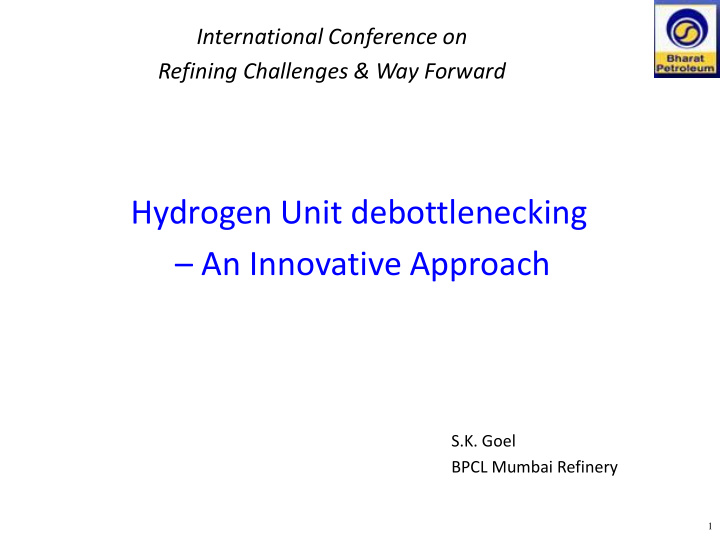



International Conference on Refining Challenges & Way Forward Hydrogen Unit debottlenecking – An Innovative Approach S.K. Goel BPCL Mumbai Refinery 1
Hydrogen Unit Process Details
Need for Innovation Unit Capacity 49,000 MTPA (148.5 MTPD) Plant Commissioned In August 2005. Hydrogen availability low because of reduced thruput, impacting HSD Production Issues – Low Pre-reformer temperature, close to hydration limits This required lower firing in bottom section of reformer, which in turn caused higher skin temperature in upper sections of the reformer. 3
Bottlenecks Unit was revamped in 2008 to include CRU off gas as part of the feed. This helped to some extent to increase pre- reformer temperature Problem aggravated with switch over reformer feed from naphtha to natural gas, since the reformer firing reduced. There was a sharp drop in Pre-reformer temperature. There were 5 tube failures, causing expensive shut down’s. Unit was operated at reduced throughput & tube max skin temperature limited to 945 deg C. 4
Possible solutions Licenser suggested to augment heat transfer area in reformer convection section. This was not found feasible, due to space limitations in the unit & needed a major revamp. Other Licensers suggested duct firing or a convective reformer. These were capital intensive & also needed higher energy consumption. 5
BPCL Innovation The innovation emerged from the following thought process. Can we use steam superheat space for process pre-heat? or Can we augment process pre-heat instead of steam superheating to such a high degree, which was really not needed. A closer look at the process revealed that part of lower temperature steam from feed heat exchanger can be exported directly, which would augment process pre- heat. The concept was agreed by Process Licenser, who supported for finalizing the process Design. 6
Prereformer Temperature Profile N H G U P re re fo rm e r Te m p e ratu re P ro file NHGU Prereformer Temperature Profile 5 1 0 510 4 9 0 Te m p e r at u r e 490 Temperature 4 7 0 470 4 5 0 450 4 3 0 430 410 4 1 0 0 20 40 60 80 100 0 2 0 4 0 6 0 8 0 1 0 0 % C ataly s t B e d % Catalyst Bed Naphtha feed case N a phtha fe e d c a s e R L N G + C R U offg a s fe e d c a s e 7
Steam Network 320 °C 8
Steam Network 320 °C 9
Post Modification – Pre-reformer Bed Temperatures 510 500 490 480 470 Naphtha Case 460 450 RLNG Case 440 430 After Modification 420 410 0 10 20 30 40 50 60 70 80 90 100 10
Results Achieved Pre-reformer minimum bed temperature increased by 15 deg C & tube skin temperature dropped by 10 deg C Fuel reduction – 4 MT/D CRU off gas – No longer essential in the feed, thus unit load can be increased independently during CRU shut down. Unit rated capacity achieved with 962 deg C max skin temperature & natural gas feed. 11
The idea won BPCL Chairman’s award at Ideas 2011 Platform. This is the highest in-house award to nurture Innovation & Talent in the organization 12
Thank you
Recommend
More recommend